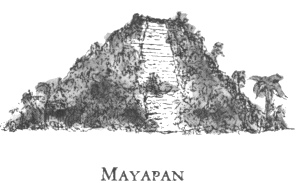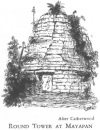
Click to enlarge
THE PYRAMID OF KUKULCAN.
As restored by the Mexican Government, under the direction of Don Eduardo Martinez
Yucatan Before and After the Conquest, by Diego de Landa, tr. William Gates, [1937], at sacred-texts.com
The opinion of the Indians is that with the Itzás who settled Chichén Itzá there ruled a great lord named Cuculcán, as an evidence of which the principal building is called Cuculcán.

Click to enlarge
THE PYRAMID OF KUKULCAN.
As restored by the Mexican Government, under the direction of Don Eduardo Martinez
They say that he came from the West, but are not agreed as to whether he came before or after the Itzás, or with them. They say that he was well disposed, that he had no wife or children, and that after his return he was regarded in Mexico as one of their gods, and called Cezalcohuati [Quetzalcóatl]. In Yucatan also he was reverenced as a god, because of his great services to the state, as appeared in the order which he established in Yucatan after the death of the chiefs, to settle the discord caused in the land by their deaths.
This Cuculcán, having entered into an agreement with the native lords of the country, undertook the founding of another city wherein he and they might live, and to which all matters and business should be brought. To this end he chose a fine site eight leagues further inland from where Mérida now lies, and some fifteen or sixteen from the sea. They surrounded the place with a very broad wall of dry stone some eighth of a league in extent, leaving only two narrow doorways; the wall itself was
 |
built their temples, calling the largest Cuculcán, the same as at Chichén Itzá. They built another circular temple, different from all others in the country, and with four entrances; also
 Click to enlarge ROUND TOWER AT MAYAPAN. After Catherwood |
Cuculcán lived for some years in this city with the chiefs, and then leaving them in full peace and amity returned by the same road to Mexico. On the way he stopped at Champotón, and there in memorial of himself and his departure he erected in the sea, at a good stone's throw from the shore, a fine edifice similar to those at Chichén Itzá. Thus did Cuculcán leave a perpetual memory in Yucatan.

Click to enlarge
CARACOL AT CHICHEN ITZA. As uncovered under the care of the Carnegie Institution of Washington